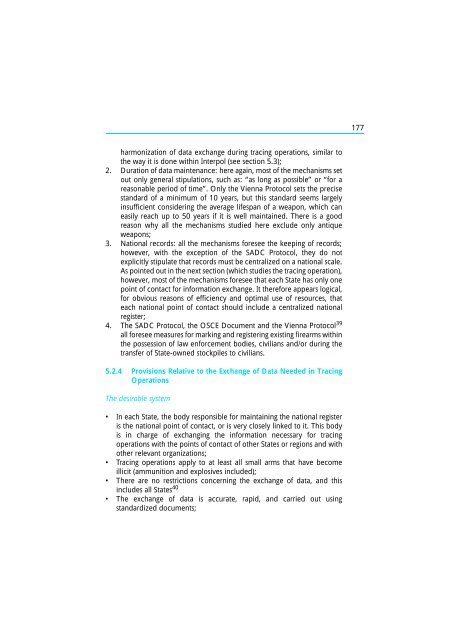The Scope and Implications of a Tracing Mechanism for Small Arms ...
The Scope and Implications of a Tracing Mechanism for Small Arms ...
The Scope and Implications of a Tracing Mechanism for Small Arms ...
Create successful ePaper yourself
Turn your PDF publications into a flip-book with our unique Google optimized e-Paper software.
177<br />
harmonization <strong>of</strong> data exchange during tracing operations, similar to<br />
the way it is done within Interpol (see section 5.3);<br />
2. Duration <strong>of</strong> data maintenance: here again, most <strong>of</strong> the mechanisms set<br />
out only general stipulations, such as: “as long as possible” or “<strong>for</strong> a<br />
reasonable period <strong>of</strong> time”. Only the Vienna Protocol sets the precise<br />
st<strong>and</strong>ard <strong>of</strong> a minimum <strong>of</strong> 10 years, but this st<strong>and</strong>ard seems largely<br />
insufficient considering the average lifespan <strong>of</strong> a weapon, which can<br />
easily reach up to 50 years if it is well maintained. <strong>The</strong>re is a good<br />
reason why all the mechanisms studied here exclude only antique<br />
weapons;<br />
3. National records: all the mechanisms <strong>for</strong>esee the keeping <strong>of</strong> records;<br />
however, with the exception <strong>of</strong> the SADC Protocol, they do not<br />
explicitly stipulate that records must be centralized on a national scale.<br />
As pointed out in the next section (which studies the tracing operation),<br />
however, most <strong>of</strong> the mechanisms <strong>for</strong>esee that each State has only one<br />
point <strong>of</strong> contact <strong>for</strong> in<strong>for</strong>mation exchange. It there<strong>for</strong>e appears logical,<br />
<strong>for</strong> obvious reasons <strong>of</strong> efficiency <strong>and</strong> optimal use <strong>of</strong> resources, that<br />
each national point <strong>of</strong> contact should include a centralized national<br />
register;<br />
4. <strong>The</strong> SADC Protocol, the OSCE Document <strong>and</strong> the Vienna Protocol 39<br />
all <strong>for</strong>esee measures <strong>for</strong> marking <strong>and</strong> registering existing firearms within<br />
the possession <strong>of</strong> law en<strong>for</strong>cement bodies, civilians <strong>and</strong>/or during the<br />
transfer <strong>of</strong> State-owned stockpiles to civilians.<br />
5.2.4 Provisions Relative to the Exchange <strong>of</strong> Data Needed in <strong>Tracing</strong><br />
Operations<br />
<strong>The</strong> desirable system<br />
• In each State, the body responsible <strong>for</strong> maintaining the national register<br />
is the national point <strong>of</strong> contact, or is very closely linked to it. This body<br />
is in charge <strong>of</strong> exchanging the in<strong>for</strong>mation necessary <strong>for</strong> tracing<br />
operations with the points <strong>of</strong> contact <strong>of</strong> other States or regions <strong>and</strong> with<br />
other relevant organizations;<br />
• <strong>Tracing</strong> operations apply to at least all small arms that have become<br />
illicit (ammunition <strong>and</strong> explosives included);<br />
• <strong>The</strong>re are no restrictions concerning the exchange <strong>of</strong> data, <strong>and</strong> this<br />
includes all States 40<br />
• <strong>The</strong> exchange <strong>of</strong> data is accurate, rapid, <strong>and</strong> carried out using<br />
st<strong>and</strong>ardized documents;
















